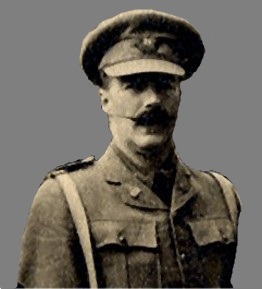|
Nov 25, 1876
|
Born in Ironbridge,
Shropshire, England to Edmund and Elizabeth (nee Clay) Southey
Ernest Southey married Sara
Sophia Wilson in England in 1896
|
|
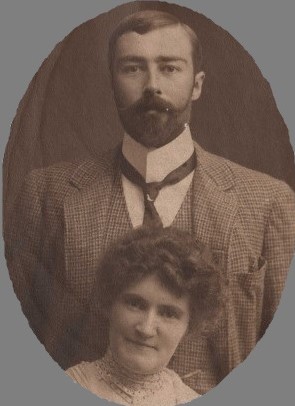
|
|
Jun 7, 1897
|
Shown on the payroll of the 46th
Regiment with the rank of 2nd Lieutenant
|
|
Jul 12, 1898
|
Shown on the payroll of the 46th
Regiment with the rank of Lieutenant
|
|
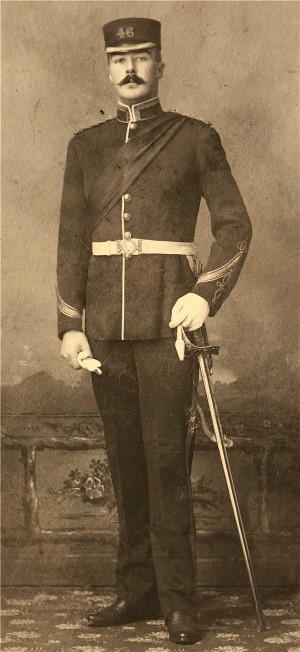
|
|
Oct 24, 1899
|
Attested into the 2nd
Special Service Battalion, Royal Canadian Regiment
Ø Number 7546
Ø Next of kin given
as Mrs. E.C. Southey, wife, Bowmanville, Ontario
Ø Previous occupation
given as Gentleman
Ø Previous military
experience given as 46th Regiment, Canadian Militia
In May of 1900, on returning
to Canada, he was transferred to the Duke of Edinburgh’s Rifle Volunteers
On his discharge in 1900 he
was entitled to the Queen’s South Africa Medal with the Cape Colony Clasp
It is later noted that he was
treated in Cape Colony for a Syphilis infection
|
|
Jun 26, 1901
|
Shown on the payroll of the 46th
Regiment in Bowmanville, Ontario, with the rank of Lieutenant
|
|
Nov 9, 1914
|
Attested into the 21st
Battalion CEF in Kingston, Ontario
Ø Rank Lieutenant
Ø Next of kin given as Mrs. Sara Sophia Southey,
wife, Bowmanville, Ontario
Ø Previous occupation given as Gentleman
o Later noted as Overseer in a Cotton Plantation in
South Africa
Ø Previous military experience given as Trooper in
Rhodesian Horse, Trooper in Matabeleland Mounted Police in South Africa,
Lieutenant in 46th Regiment Canadian Militia, Corporal in 1st
Battalion Royal Canadian Regiment in South Africa
Ø Religion given as Church of England
Ø Posted to “D” Company
o This was later reorganized into “B” Company
The battalion trained in the
Kingston area through the winter with headquarters in the Kingston Armouries
|
|
Feb 11, 1915
|
Qualified for the rank of a
Field Officer
|
|
Apr 13, 1915
|
Qualified in the use of a
Machine Gun
|
|
May 6, 1915
|
Embarked the RMS Metagama in
Montreal, Quebec

|
|
May 15, 1915
|
Disembarked in Devonport,
England and the battalion proceeded to the West Sandling Camp, near Hythe,
Kent to continue training
|
|
Aug 10, 1915
|
Appointed as the battalion’s
Bomb Throwing Officer
|
|
Sep 14, 1915
|
Embarked the St. Seiriol in
Folkestone
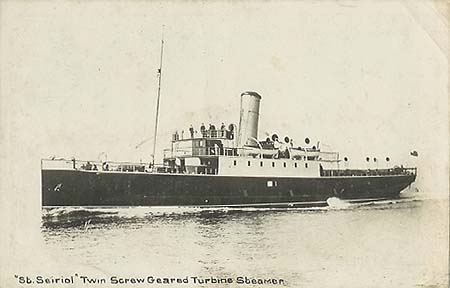
|
|
Sep 15, 1915
|
Disembarked in Boulogne,
France and the battalion proceeded to St. Omer
|
|
Jan 2, 1916
|
Admitted to the No. 5 CFA
(Canadian Field Ambulance) and transferred to the Division Rest Station at
Mont Noir with a diagnosis that reads Influenza
|
|
Jan 7, 1916
|
Discharged to duty from the
rest station
|
|
Feb 21, 1916
|
While on a work party near La
Clytte, Belgium, he received a wound to his right arm that caused a bruise.
|
|
Feb 22, 1916
|
Admitted to the No. 5 Canadian
Field Ambulance and transferred to the Division Rest Station with a diagnosis
that reads bruised right arm
|
|
Feb 23, 1916
|
Discharged to duty from the
rest station
|
|
Mar 14, 1916
|
Lieutenant Ernest Southey was
brought before a Court Martial in Locre, Belgium on the charge of being drunk
on duty
Ø Charged with being
drunk on the night of February 21, 1916 while in charge of a work party
Ø Testimony by the
Medical Officer at the field ambulance stated that Lieutenant Southey came to
him with a bruised arm and that he required no treatment. However, it was noted that he appeared to
be drunk
Ø 2 others testified
that he had been seen in the Brasserie earlier in the evening drinking
Ø 2 others testified
that he had been given drinks after he reported being wounded
He was found guilty of the
charge and sentenced to be dismissed from the CEF.
This sentence was reduced by
the General Officer Commanding, Brigadier General R. Rennie, MVO, DSO, to be
a Severe Reprimand
|
|
Apr 7, 1916
|
Admitted to the No. 10 CCS
(Casualty Clearing Station) with a severely sprained right ankle and
transferred the same day to the No. 14 Canadian General Hospital in Wimereux. Tabes Dorsalis (nerve degeneration caused
from a previous Syphilis infection) was added to the diagnosis
|
|
May 6, 1916
|
Invalided to England aboard
the Hospital Ship Aberdonian

On arrival in England he was
admitted to the Queen Alexandra Military Hospital, Millbank, with a diagnosis
that reads Tabes Dorsalis. Locomoter
Ataxia (an inability to control body movements) is also added to the
diagnosis
Transferred to the General
List of Officers and attached to the 39th Reserve Battalion for
pay purposes while in hospital
|
|
May 15, 1916
|
Medical Board declares that he
is unfit for General Service permanently
Granted leave to Canada until
August 15, 1916
|
|
May 23, 1916
|
Embarked the SS Pretorian in
Liverpool
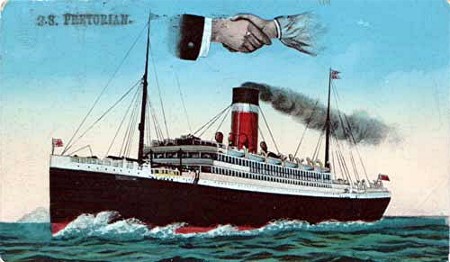
|
|
Jun 4, 1916
|
Disembarked in Montreal, Quebec
and proceeded to Bowmanville, Ontario
|
|
Aug 2, 1916
|
Struck Off Strength the
overseas CEF on being transferred to the 235th Battalion in
Bowmanville, Ontario
|
|
Sep 29, 1916
|
Promoted to the rank of
Captain and made effective July 27, 1916
|
|
Oct 4, 1916
|
Promoted to the rank of Major
|
|
Mar 15, 1917
|
Ernest Clay Southey resigned
his Commission and was discharged from the CEF in Bowmanville, Ontario
He was discharged to the care
of the SCR (Department of Soldier’s Civil Re-establishment)
Following his discharge, the
1914-15 Star, British War Medal and Victory Medals were sent to him at Box 296
Elgin St., Bowmanville, Ontario
|
|
Jan 25, 1918
|
Appointed as a representative
for Military District #3 to the Department of Soldier’s Civil
Re-establishment
|
|
Jun 29, 1918
|
Medical Board in Kingston, Ontario
notes
Ø Suffers from Tabes
Dorsalis
Ø Complains of
weakness of ankles
Ø Loss of sensation
in the soles of his feet
Ø States he was
treated in Cape Town, South Africa, for Syphilis, but no treatment since
Ø He is unable to
resume former occupation
Ø Sways when standing
and shuffles when he walks
|
|
Oct 1, 1918
|
Admitted to the Ontario
Military Hospital in Cobourg, Ontario with a diagnosis that reads Tabes
Dorsalis
|
|
Oct 11, 1918
|
Discharged from hospital
|
|
Feb 20, 1930
|
Ernest Clay Southey died while
a patient at the Westminster Hospital, London, Ontario. The cause of death was shown as General
Paralysis of the Insane, caused by his previous Syphilis infection suffered
in South Africa. The death certificate
indicates he had been a patient in the hospital for 8 years.
|
|

|
|
|
He was later buried in the
Bowmanville Cemetery, Bowmanville, Ontario
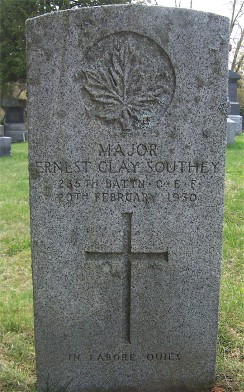
Interestingly, his death was
determined to be a result of Active Service, and a Plaque (Dead Man’s Penny),
Scroll and Memorial Cross were issued to his widow, Mrs. Sara Southey, Bowmanville,
Ontario
|
|
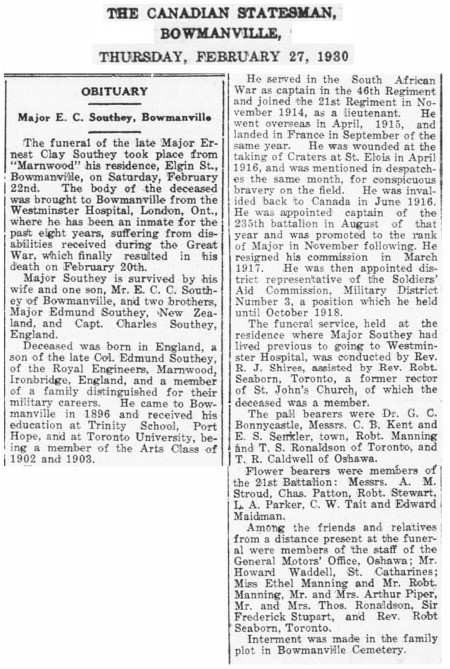
|
|
